Quick Summary:
- Plan your niche, business model, and legal steps.
- Implement key features for a great user experience.
- Build your site, test thoroughly, and launch strategically.
- Market effectively and continuously optimize for success.
Table of Contents
- Section 1: Understanding the Auction House Website Landscape
- 1.1. What is an Auction House Website?
- 1.2. Why Build an Online Auction Platform? Unveiling the Benefits
- 1.3. Key Features of a Successful Auction House Website
- 1.4. Auction Types: Choosing the Right Model
- Section 2: Planning Your Auction House Website
- 2.1. Defining Your Niche and Target Audience
- 2.2. Business Model and Revenue Streams
- 2.3. Legal and Regulatory Considerations
- 2.4. Domain Name and Hosting
- Section 3: Building Your Auction House Website: Step-by-Step Guide
- 3.1. Choosing a Platform: Custom Development vs. Ready-Made Solutions
- 3.2. Setting Up Your Chosen Platform
- 3.3. Designing Your Website: User Interface (UI) and User Experience (UX)
- 3.4. Implementing Core Auction Features
- 3.5. Testing and Optimization
- Section 4: Launching and Promoting Your Auction House Website
- 4.1. Pre-Launch Checklist
- 4.2. Marketing and Promotion Strategies
- 4.3. Monitoring and Maintenance
- Section 5: Advanced Strategies for Auction House Success
- 5.1. Enhancing User Experience
- 5.2. Building Trust and Credibility
- 5.3. Data Analysis and Optimization
- Section 6: Qrolic Technologies: Your Partner in Building a Cutting-Edge Auction Platform
- 6.1. Why Choose Qrolic Technologies?
- 6.2. Qrolic Technologies’ Services for Auction House Websites
- 6.3. Transforming Your Vision into Reality
- Section 7: Conclusion: Building Your Auction Empire
Section 1: Understanding the Auction House Website Landscape
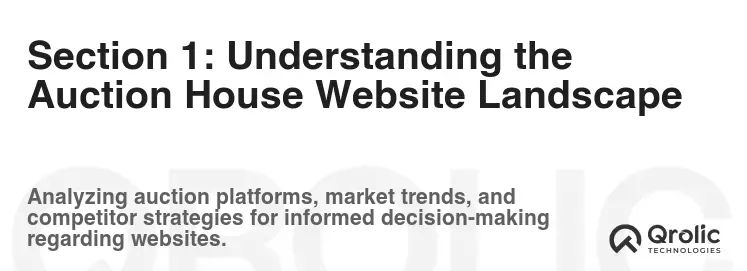
1.1. What is an Auction House Website?
An auction house website, at its core, is a digital marketplace where items are offered for sale through a bidding process. Unlike traditional e-commerce platforms with fixed prices, auction sites allow potential buyers to compete against each other, driving up the price of an item until the auction ends. This dynamic environment attracts both sellers looking to maximize their profits and buyers hoping to snag a valuable item at a competitive price.
1.2. Why Build an Online Auction Platform? Unveiling the Benefits
Building an auction house website offers a plethora of benefits, both for the platform owner and its users.
-
Expanded Reach: Brick-and-mortar auction houses are limited by geography. An online platform transcends these limitations, reaching a global audience of potential buyers and sellers.
-
Reduced Overhead Costs: Compared to running a physical auction house, an online platform significantly reduces overhead costs associated with rent, utilities, staffing, and security.
-
24/7 Availability: Online auction sites operate around the clock, allowing users to bid and sell items at any time, regardless of their location or time zone.
-
Increased Competition & Higher Prices: The global reach of an online platform fosters increased competition among bidders, which can drive up the final sale price of items.
-
Data-Driven Insights: Online platforms generate vast amounts of data on user behavior, bidding patterns, and item popularity. This data can be used to optimize the platform, personalize the user experience, and improve marketing efforts.
-
Specialized Niches: Online auction sites can cater to specialized niches, such as fine art, antiques, collectibles, real estate, or even charitable fundraising auctions. This allows you to target a specific audience with tailored offerings.
-
Enhanced Transparency & Security: Online auction platforms offer enhanced transparency through detailed item descriptions, high-quality images, and secure payment gateways. Reputable platforms also implement robust security measures to protect user data and prevent fraud.
-
Scalability: An online platform can easily scale to accommodate a growing user base and expanding inventory.
-
Automated Processes: Many aspects of the auction process, such as bidding increments, auction closing times, and payment processing, can be automated, streamlining operations and reducing administrative burden.
1.3. Key Features of a Successful Auction House Website
To build a successful auction house website, it’s crucial to incorporate key features that enhance the user experience and streamline the auction process.
-
User Registration and Profiles: Secure user registration and comprehensive profile management are essential for building trust and managing user information. Users should be able to easily update their profiles, track their bidding activity, and manage their payment methods.
-
Item Listing and Management: Sellers need a user-friendly interface to create detailed listings with high-quality images, descriptions, and relevant information. The system should also allow them to manage their listings, set starting prices, reserve prices, and auction durations.
-
Bidding Functionality: The core of any auction platform is its bidding functionality. This should include real-time bidding updates, automatic bidding options (proxy bidding), and clear visual cues to indicate the current high bidder.
-
Search and Filtering: Robust search and filtering options allow users to quickly find items of interest based on keywords, categories, price range, location, and other relevant criteria.
-
Watch Lists: Allow users to save items of interest to their watch lists, so they can easily track their progress and receive notifications when bidding is about to close.
-
Notifications and Alerts: Real-time notifications and alerts keep users informed about bidding activity, outbid notifications, auction closings, and payment confirmations.
-
Payment Gateway Integration: Seamless integration with secure payment gateways (e.g., PayPal, Stripe) is essential for processing payments and ensuring secure financial transactions.
-
Auction Management Tools: The platform should provide administrators with tools to manage auctions, monitor bidding activity, resolve disputes, and generate reports.
-
Reporting and Analytics: Comprehensive reporting and analytics provide valuable insights into platform performance, user behavior, and item popularity.
-
Responsive Design: The website must be responsive and accessible across all devices, including desktops, laptops, tablets, and smartphones.
-
Security Features: Robust security measures, such as SSL encryption, fraud detection, and user authentication, are crucial for protecting user data and preventing fraudulent activity.
1.4. Auction Types: Choosing the Right Model
Different auction types cater to different needs and preferences. Understanding the various models is crucial for designing your bidding platform design effectively.
-
English Auction (Ascending Price Auction): The most common type, where bidders openly compete against each other, raising the price until only one bidder remains.
-
Dutch Auction (Descending Price Auction): The auctioneer starts with a high price and gradually lowers it until a bidder accepts the price. This is often used for selling multiple identical items.
-
Sealed-Bid Auction: Bidders submit their bids privately, and the highest bidder wins. This is commonly used for government contracts or high-value items where transparency is not desired.
-
Reverse Auction: Buyers specify what they want to purchase, and sellers compete to offer the lowest price. This is often used for procurement and sourcing.
-
Proxy Bidding (Automatic Bidding): Bidders set a maximum price they are willing to pay, and the system automatically bids on their behalf, incrementally increasing the bid to stay in the lead, up to their specified maximum.
-
Timed Auction: Auctions with a fixed duration, providing a clear deadline for bidding.
Section 2: Planning Your Auction House Website
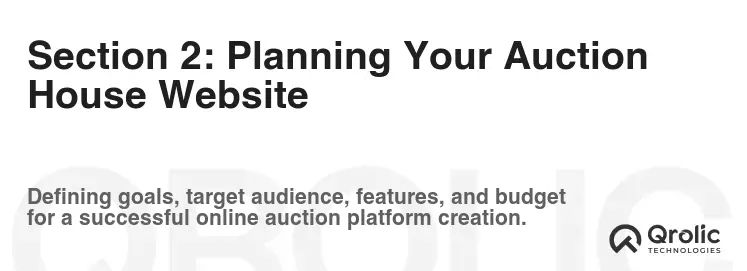
2.1. Defining Your Niche and Target Audience
Before diving into development, it’s crucial to define your niche and target audience. A niche allows you to specialize and attract a specific group of buyers and sellers.
-
Identify Your Passion: What are you passionate about? What areas do you have expertise in?
-
Market Research: Research the market to identify underserved niches or areas with high demand.
-
Target Audience Demographics: Define the demographics of your target audience (age, location, income, interests).
-
Competitor Analysis: Analyze your competitors to identify their strengths and weaknesses.
Examples of Niches:
- Fine Art Auction House
- Vintage Collectibles Auction House
- Luxury Real Estate Auction House
- Online Auto Auction
- Charity Auction Platform
2.2. Business Model and Revenue Streams
Develop a clear business model that outlines how you will generate revenue.
-
Commission Fees: Charge a commission on each successful sale. This is the most common revenue model.
-
Listing Fees: Charge sellers a fee for listing their items on the platform.
-
Membership Fees: Offer premium memberships with enhanced features and benefits.
-
Advertising: Display targeted advertisements on the platform.
-
Featured Listings: Charge sellers extra for featuring their listings prominently.
-
Transaction Fees: Charge a small fee for each transaction processed through the platform.
2.3. Legal and Regulatory Considerations
Ensure you comply with all applicable laws and regulations.
-
Terms of Service: Create comprehensive terms of service that outline the rules and regulations of the platform.
-
Privacy Policy: Develop a clear privacy policy that explains how you collect and use user data.
-
Auction Laws: Comply with all relevant auction laws and regulations in your jurisdiction.
-
Intellectual Property: Protect your intellectual property (e.g., trademarks, copyrights).
-
Payment Processing Regulations: Comply with all payment processing regulations and security standards (e.g., PCI DSS).
2.4. Domain Name and Hosting
Choose a domain name that is relevant, memorable, and easy to spell. Select a reliable hosting provider that can handle the traffic and data storage requirements of your auction platform.
-
Domain Name Selection: Choose a domain name that reflects your brand and niche.
-
Hosting Provider Selection: Select a hosting provider that offers scalability, security, and reliable uptime.
-
SSL Certificate: Obtain an SSL certificate to encrypt data transmitted between users and the website.
Section 3: Building Your Auction House Website: Step-by-Step Guide
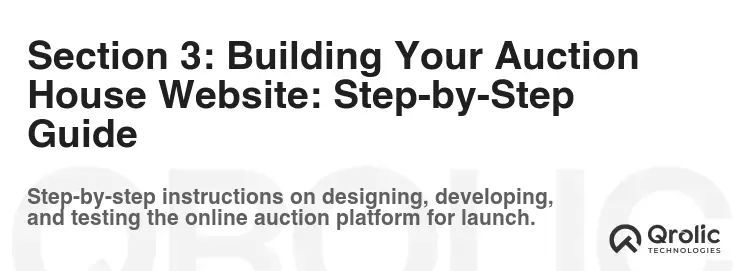
3.1. Choosing a Platform: Custom Development vs. Ready-Made Solutions
You have two main options for building your auction house website: custom development or using a ready-made solution.
Custom Development:
- Pros: Maximum flexibility, complete control over design and functionality, tailored to your specific needs.
- Cons: Higher cost, longer development time, requires technical expertise.
Ready-Made Solutions (Auction Software):
- Pros: Lower cost, faster deployment, pre-built features, often user-friendly.
- Cons: Limited customization, potential security vulnerabilities, reliance on third-party vendor.
Choosing the Right Option:
-
Custom Development: Best for complex projects with unique requirements and a large budget.
-
Ready-Made Solutions: Best for smaller projects with limited budgets and less demanding requirements.
Popular Auction Software Platforms:
- Magento
- wordpress with Auction Plugins
- Dedicated Auction Software (e.g., AuctionWorx, Webid)
3.2. Setting Up Your Chosen Platform
The setup process will vary depending on the platform you choose. However, here are some general steps:
-
Install the Platform: Follow the installation instructions provided by the platform vendor.
-
Configure Basic Settings: Configure basic settings such as website name, logo, currency, and time zone.
-
Install Necessary Plugins or Modules: Install plugins or modules that provide essential auction functionality.
-
Configure Payment Gateways: Integrate with your chosen payment gateways to process payments securely.
3.3. Designing Your Website: User Interface (UI) and User Experience (UX)
A well-designed website is crucial for attracting and retaining users.
-
Professional Design: Invest in a professional design that reflects your brand and niche.
-
User-Friendly Navigation: Ensure easy navigation with clear menus and intuitive search functionality.
-
Responsive Design: Design the website to be responsive and accessible across all devices.
-
High-Quality Images: Use high-quality images to showcase items effectively.
-
Clear Call-to-Actions: Use clear call-to-actions to guide users through the auction process.
-
Fast Loading Speed: Optimize the website for fast loading speed to improve user experience.
3.4. Implementing Core Auction Features
Implement the core auction features described in Section 1.3:
-
User Registration and Profiles: Secure user registration and profile management.
-
Item Listing and Management: User-friendly interface for creating and managing listings.
-
Bidding Functionality: Real-time bidding updates, automatic bidding options (proxy bidding).
-
Search and Filtering: Robust search and filtering options.
-
Watch Lists: Allow users to save items to their watch lists.
-
Notifications and Alerts: Real-time notifications and alerts.
-
Payment Gateway Integration: Seamless integration with secure payment gateways.
-
Auction Management Tools: Tools for administrators to manage auctions.
-
Reporting and Analytics: Comprehensive reporting and analytics.
3.5. Testing and Optimization
Thoroughly test the website before launching to identify and fix any bugs or issues.
-
Functional Testing: Test all features to ensure they are working correctly.
-
Usability Testing: Conduct usability testing to identify areas for improvement.
-
Performance Testing: Test the website’s performance under load to ensure it can handle high traffic.
-
Security Testing: Conduct security testing to identify and fix any vulnerabilities.
-
A/B Testing: Use A/B testing to optimize design elements and improve conversion rates.
Section 4: Launching and Promoting Your Auction House Website

4.1. Pre-Launch Checklist
Before launching your auction house website, ensure you have completed the following tasks:
-
Final Testing: Perform a final round of testing to ensure everything is working correctly.
-
Content Review: Review all content for accuracy and clarity.
-
Security Audit: Conduct a security audit to identify and fix any remaining vulnerabilities.
-
Backup and Recovery Plan: Create a backup and recovery plan to protect your data.
-
Launch Plan: Develop a launch plan that outlines your marketing and promotion strategies.
4.2. Marketing and Promotion Strategies
Effective marketing is crucial for attracting users to your auction platform.
-
Search Engine Optimization (SEO): Optimize your website for search engines to improve visibility in search results. Use keywords like auction house website, step-by-step guide, and bidding platform design naturally throughout your content.
-
Social Media Marketing: Promote your website on social media platforms to reach a wider audience.
-
Email Marketing: Build an email list and send targeted email campaigns to promote auctions and new listings.
-
Paid Advertising (PPC): Use paid advertising platforms like Google Ads to target potential buyers and sellers.
-
Content Marketing: Create valuable content (e.g., blog posts, articles, videos) related to your niche to attract and engage users.
-
Partnerships: Partner with other businesses in your niche to cross-promote your services.
-
Public Relations (PR): Reach out to journalists and bloggers to get media coverage for your auction platform.
-
Influencer Marketing: Partner with influencers in your niche to promote your website to their followers.
4.3. Monitoring and Maintenance
Continuously monitor your website’s performance and maintain it regularly to ensure it is running smoothly.
-
Website Analytics: Monitor website traffic, user behavior, and conversion rates using analytics tools like Google Analytics.
-
Server Monitoring: Monitor server performance to ensure uptime and prevent downtime.
-
Security Monitoring: Monitor for security threats and vulnerabilities.
-
Software Updates: Regularly update your platform and plugins to address security vulnerabilities and improve performance.
-
Database Maintenance: Perform regular database maintenance to optimize performance.
-
Content Updates: Keep your content fresh and up-to-date.
Section 5: Advanced Strategies for Auction House Success
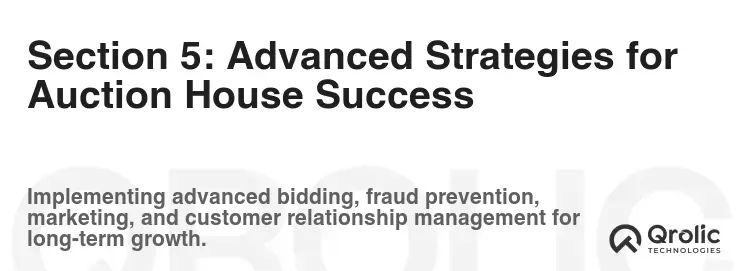
5.1. Enhancing User Experience
Continuously strive to improve the user experience to attract and retain users.
-
Personalization: Personalize the user experience based on user preferences and behavior.
-
Gamification: Incorporate gamification elements to make the auction process more engaging.
-
Mobile App: Develop a mobile app to provide users with a convenient way to bid and sell items on the go.
-
Live Streaming: Offer live streaming auctions to provide a more immersive and engaging experience.
-
Virtual Reality (VR): Explore the use of VR to create virtual auction environments.
5.2. Building Trust and Credibility
Building trust is essential for attracting buyers and sellers to your platform.
-
Secure Payment Processing: Use secure payment gateways to protect user financial information.
-
Verified Sellers: Implement a system for verifying sellers to ensure their authenticity.
-
Dispute Resolution: Provide a fair and efficient dispute resolution process.
-
Customer Support: Offer excellent customer support to address user questions and concerns.
-
Transparency: Be transparent about your fees, policies, and procedures.
-
Reviews and Ratings: Allow users to leave reviews and ratings for sellers and items.
5.3. Data Analysis and Optimization
Leverage data analysis to optimize your platform and improve performance.
-
Identify Trends: Analyze data to identify trends in user behavior, bidding patterns, and item popularity.
-
Optimize Pricing: Use data to optimize pricing strategies and maximize revenue.
-
Personalize Marketing: Use data to personalize marketing campaigns and improve conversion rates.
-
Improve Search Functionality: Use data to improve search functionality and help users find items more easily.
-
Enhance Security: Use data to identify and prevent fraudulent activity.
Section 6: Qrolic Technologies: Your Partner in Building a Cutting-Edge Auction Platform
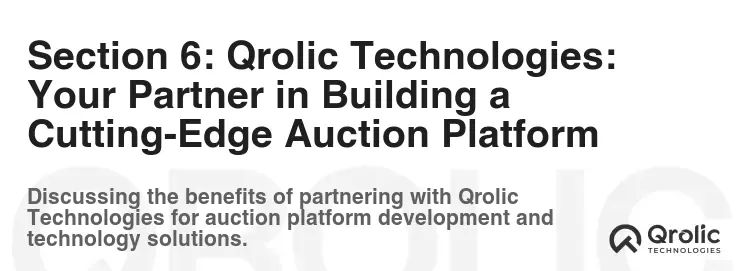
Building a successful auction house website requires a strong technology partner. Qrolic Technologies (https://qrolic.com/) offers a comprehensive suite of services to help you create a cutting-edge bidding platform design that meets your specific needs.
6.1. Why Choose Qrolic Technologies?
-
Expertise in Auction Platform Development: Qrolic Technologies has extensive experience in developing custom auction platforms for various industries.
-
Custom Software Development: They offer custom software development services tailored to your unique requirements.
-
Mobile App Development: They can develop mobile apps for iOS and Android to provide users with a convenient way to bid and sell items on the go.
-
UI/UX Design: They provide professional UI/UX design services to create a user-friendly and engaging auction platform.
-
Integration Services: They can integrate your auction platform with various third-party services, such as payment gateways, shipping providers, and CRM systems.
-
Scalable Solutions: They build scalable solutions that can handle a growing user base and expanding inventory.
-
Dedicated Support: They provide dedicated support to ensure your auction platform is running smoothly.
6.2. Qrolic Technologies’ Services for Auction House Websites
-
Custom Auction Platform Development: Developing a bespoke auction platform from the ground up, tailored to your specific niche and requirements.
-
Auction Software Customization: Customizing existing auction software to meet your specific needs and branding.
-
Mobile App Development (iOS and Android): Creating native mobile apps for your auction platform, providing a seamless mobile experience for your users.
-
Payment Gateway Integration: Integrating secure payment gateways like PayPal, Stripe, and Authorize.net.
-
Database Design and Management: Designing and managing robust databases to store and manage auction data.
-
Cloud Hosting and Scalability: Providing cloud hosting solutions that can scale to handle increased traffic and data storage needs.
-
Security Audits and Vulnerability Testing: Conducting security audits and vulnerability testing to ensure your auction platform is secure.
-
Ongoing Maintenance and Support: Providing ongoing maintenance and support to keep your auction platform running smoothly.
6.3. Transforming Your Vision into Reality
Qrolic Technologies understands the intricacies of the auction industry and is committed to helping you build a successful online auction platform. Whether you are looking to create a niche auction site or a large-scale marketplace, they have the expertise and resources to transform your vision into reality. By partnering with Qrolic Technologies, you can leverage their experience and technology to create a cutting-edge auction house website that attracts buyers and sellers, drives revenue, and establishes your brand as a leader in the online auction space.
Section 7: Conclusion: Building Your Auction Empire

Creating a successful auction house website requires careful planning, meticulous execution, and a commitment to continuous improvement. By following this step-by-step guide, understanding the key features of a successful bidding platform design, and leveraging the expertise of partners like Qrolic Technologies, you can build a thriving online auction empire that connects buyers and sellers from around the world. The journey may be challenging, but the rewards of owning a successful auction platform are well worth the effort. Embrace the dynamic nature of the online auction world, adapt to changing market trends, and continuously innovate to stay ahead of the competition. Good luck building your auction empire!







